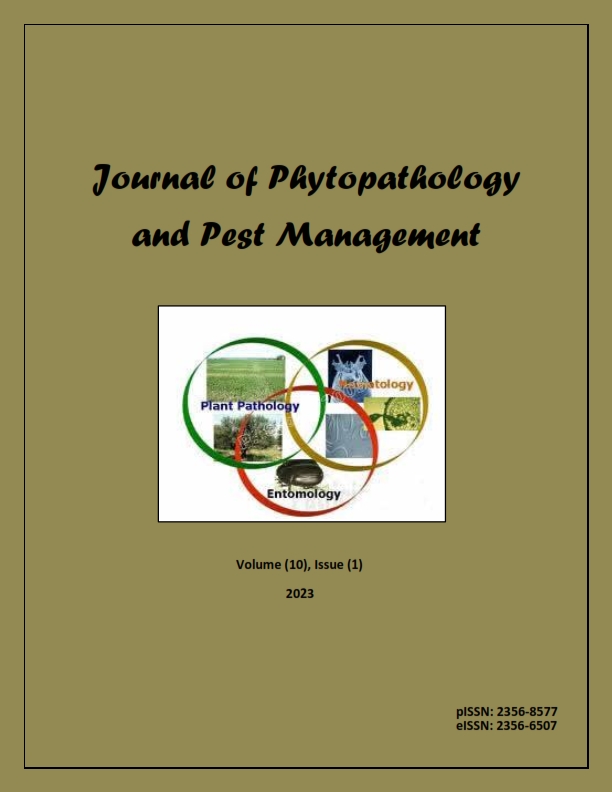Morpho-molecular identification and management of Erysiphe heraclei causing dill powdery mildew using a biocide, essential oils, and organic acids
DOI:
https://doi.org/10.5281/zenodo.10076646Keywords:
dill, Erysiphe heraclei, powdery mildew, Bio-Cur F, thyme essential oil, salicylic acidAbstract
This study aimed to evaluate the efficacy of Bio-Cure F, essential oils of thyme and clove, ascorbic and salicylic acids in controlling dill powdery mildew under greenhouse conditions. The causal pathogen of powdery mildew was isolated from infected dill plants showing symptoms of the disease during a survey in Fayoum governorate, Egypt, in 2022. Erysiphe heraclei was morphologically characterized using a light microscope as the causal pathogen of powdery mildew in infected dill plants. The nucleotide sequence of the internal transcribed spacer (ITS) of the causal pathogen DNA was deposited in GenBank (Accession No. OP999071.1), which showed 98-100% similarity with accession numbers of E. heraclei isolates obtained from the NCBI database. Under greenhouse conditions, dill plants were sprayed with biocide (Bio-Cure F), elicitors (ascorbic and salicylic acids), and essential oil emulsions of clove and thyme three times after inoculation with E. heraclei. The results showed that Bio-Cure F was the treatment that showed the highest efficacy in reducing both disease severity and incidence percentage, followed by thyme essential oil. The highest percentages of increase in dill plant height (cm) as well as branches/plant were obtained by Bio-Cure F treatment compared to the control, followed by salicylic acid treatment. The results suggest that Bio-Cure F, salicylic acid, and thyme oil emulsion could be used to control dill powdery mildew.
Metrics
Published
How to Cite
Issue
Section
URN
ARK
License
Copyright (c) 2023 Journal of Phytopathology and Disease Management

This work is licensed under a Creative Commons Attribution-NonCommercial 4.0 International License.
Authors who publish with Journal of Phytopathology and Disease Management agree to the following terms:
- Authors retain copyright and grant the journal right of first publication with the work simultaneously licensed under a Creative Commons Attribution License that allows others to share the work with an acknowledgement of the work's authorship and initial publication in this journal.
- Authors retain copyright and grant the journal right of first publication with the work simultaneously licensed under the Creative Commons Attribution-Non Commercial License (CC BY-NC). This allows others to share the work with an acknowledgement of the work's authorship and initial publication in this journal.
- Archives of Agricultural Sciences Journal is an Open Access Journal, and articles published are distributed under the terms of the Creative Commons Attribution-Non Commercial License (CC BY-NC). Readers may copy, distribute, and display the work for non commercial purposes with the proper citation of the original work. However, the journal retains the right to exploit subsidiary rights on behalf of the authors.
- Authors are able to enter into separate, additional contractural arrangements for the non-exclusive distribution of the journal's published version of the work (e.g. post it to an institutional repository or publish it in a book), with an acknowledgement of its initial publication in this journal.
- Authors are permitted and encouraged to post their work online (e.g., in institutional repositories or on their website) prior to and during the submission process with full disclosure to the journal, as it can lead to productive exchanges, as well as earlier and greater citation of published work. Following publication in Archives of Agricultural Sciences Journal, the author should update the repository, and include a citation and link to the published work.
Click here for more information on Licensing policy

.png)




